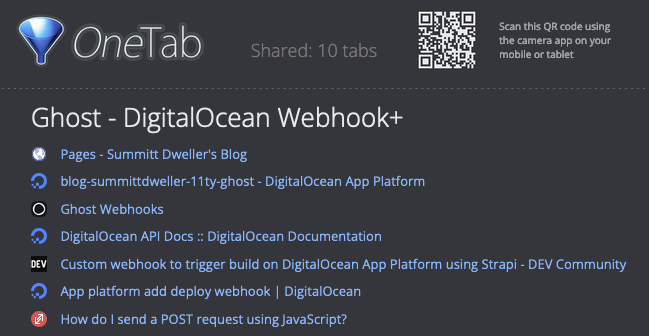
Built by Webhook + Password Protection
2023-03-24 - ~3 Minutes
Today I used the resources you see in the OneTab shown above to build a trigger from a password-protected page in this blog to a DigitalOcean webhook. The purpose of the webhook is to rebuild and subsequently deploy the entire blog.
I thought about using a traditional Ghost action, like site.changed, to do this but I frequently like to post 3 or more blog updates in rapid succession, and I didn’t want Ghost triggering back-to-back-to-back rebuilds all of the time. Why not? Because I’m cheap and I didn’t want to blow through the limited quota of build minutes that my inexpensive DigitalOcean account provides.
My https://blog.SummittDweller.com/rebuild.html -> DigitalOcean trigger and webhook should do the job nicely since I’ll be able to trigger it even from my iPhone when needed.
The POST in rebuild.njk
Sometime soon I hope to create a diagram showing all the components and relationships/communication between the parts, but for now this brief explanation will have to suffice.
rebuild.njk is a Nunjucks template at the root of my Eleventy site with a defined permalink of rebuild.html. Inside that .njk is a POST script that begins in the third line of the snippet shown below.
{% extends 'layouts/default.njk' %}
{% set codeinjection_head = "<script>
fetch('https://api.digitalocean.com/v2/apps/86d9d69d-4a0e-4686-931b-69650094db15/deployments', {
method: 'POST',
headers: {
'Accept': 'application/json',
'Content-Type': 'application/json',
'Authorization': 'Bearer ********** obfuscated ************',
},
body: JSON.stringify({ 'force_build': true })
})
.then(response => response.json())
.then(response => console.log(JSON.stringify(response)))
</script>" %}
{% set codeinjection_foot = doc.codeinjection_foot %}
{% set title = "Rebuild!" %}
...
The *** obfuscated *** portion is a secret.
DigitalOcean’s Response
That POST, when received by DigitalOcean, signals DO to trigger a rebuild of the site which has been programmed in the apps’ DO settings to execute a build command of yarn build followed by yarn encrypt.
The first command, build is defined in package.json, and using .eleventy.js it builds the site into a static collection of files in the project’s ./dist directory.
The second command, encrypt, also defined in package.json, executes the staticrypt utility to encrypt ./dist/rebuild.html placing a login page in front of it.
StatiCrypt
The encryption provided by StatiCrypt effectively “hides” the authorization token, obfuscated above, from pyring eyes.
I built the encryption process in this site based on previous experience described in Protecting Pages with StatiCrypt CLI and the references listed therein. I borrowed pieces of several files from the project chronicled in that blog post, namely:
auth/login.html - The login page that gets placed in front of rebuild.html
The encrypt script definition which appears in package.json. It reads:
"encrypt": "staticrypt ./dist/rebuild.html '***************' --short -o ./dist/rebuild.html -f ./src/auth/login.html -t 'Summitt Dweller Blog - Rebuild' -i 'Please enter the passphrase.<br/>Hint: gh0st' --label-error 'Sorry, Ella says no. Try again.'"
The "staticrypt": "^2.4.0" addition to the dependencies: portion of package.json
The - run: yarn encrypt addition to the end of the steps: of the project’s .github/workflows/build-and-deploy.yml file.